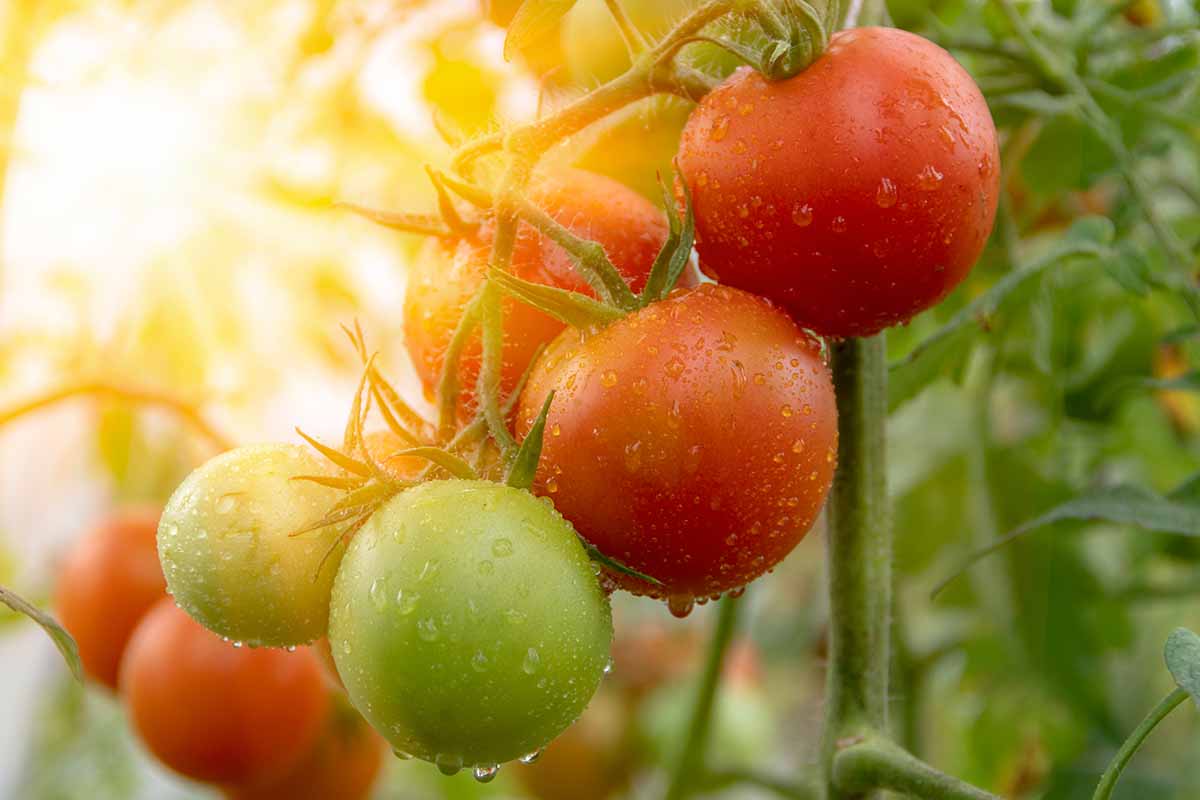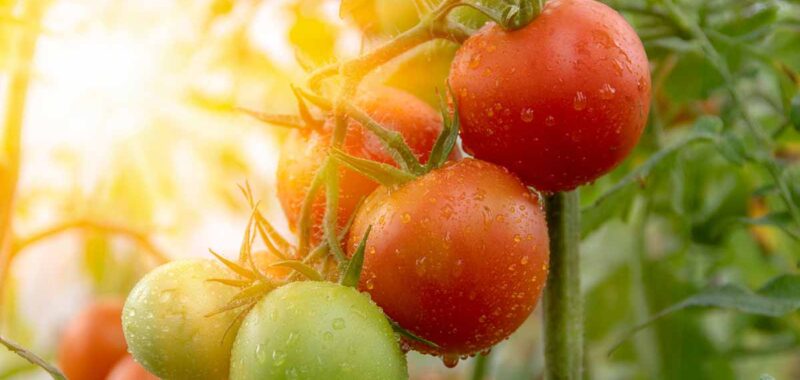I might be about to blow your mind by telling you this, but when it comes to growing tomatoes, there is such a thing as too much sun.
We always hear about how important it is to plant tomatoes in as much sunlight as possible with lots of heat, and that advice generally holds true.
However, it’s possible for the fruits to be exposed to too much light, especially during hot and humid conditions, and when that happens, it can result in sunscald.


We link to vendors to help you find relevant products. If you buy from one of our links, we may earn a commission.
Tomatoes require around eight hours of sun per day, but more than that, especially during the hottest part of the year, isn’t ideal.
You can learn more about the perfect conditions for growing tomatoes in our guide.
When tomatoes suffer from sunscald, it can mean saying goodbye to those particular fruits.
It’s pretty easy to avoid this condition, though. We’ll explain how to do that and why this disorder happens in the first place, in this guide.
Here’s what I’ll cover:
I’m sure you’re excited to get to the part where you find out how to deal with the problem, but let’s first define what sunscald is.
What Is Sunscald?
Sunscald isn’t a disease; it’s a physiological disorder, which means it’s caused by environmental issues rather than pathogens.
The good news is this generally means you can take action to prevent the disorder when you understand the cause.


Sunscald, as the name suggests, happens when a fruit is exposed to too much direct light.
I know what you’re thinking because I thought the same when I first encountered this problem. How on Earth can a tomato have too much light?
Whenever I planted a new garden, I would always spend a good amount of time finding the sunniest spot in my yard because tomatoes seem to live by the philosophy that there’s no such thing as too much sunlight.
But in fact it is possible to have too much of a good thing!
Let’s dive deeper into what causes this disorder.
Causes
Sunscald isn’t just a result of growing your plants in too much sun. The plant generally adapts to the amount of sun it receives where it is planted.
This condition is more the result of the exposure changing for some reason after the fruits have already started to develop – or during extremely hot periods.


It’s kind of like how I get sunburnt every spring because my skin isn’t prepared for the exposure after the famously gloomy Pacific Northwest winter.
For example, maybe powdery mildew, early blight, or hornworms caused the leaves around a fruit to disappear. At this point, the fruit isn’t protected by the foliage and it’s receiving a lot more light than it was previously.
Or maybe you decided to prune your tomatoes and mistakenly took off some leaves that were protecting the fruits.
One year, I didn’t realize that the angle of the sun had changed such that the light was reflecting off a window and directly onto my tomatoes and peppers for part of the day. You’d better believe my fruit had sunscald that year.
This disorder rarely occurs when the weather is cool. It goes hand-in-hand with intense hot temperatures.
In fact, it can even occur when the conditions are dry and hot without a change in sun exposure.
Symptoms
Sunscald can look similar to other common issues, but there are a variety ways to tell it apart.
Young, green fruit will develop light green, yellow, light brown, or white patches with a leathery texture.


On more mature fruit, these spots appear as pale yellow or white, or they may be brown and leathery.
The lesions are generally circular or uneven splotches on the part of the fruit exposed to the sun.
Over time, the patch flattens out and might take on a gray hue. The impacted skin might also wrinkle or blister.
The patch will eventually dry out and if you touch it, the skin will feel distinctly papery compared to the slick, firm skin on the rest of the fruit. It may also be sunken.
The sunburned patch will be susceptible to infection by opportunistic pathogens, which means it might be invaded by fungi or bacteria. If this occurs, you might see fungal spores, rot, or further discoloration.


The foliage might also be impacted. When it is, the leaves will develop white, yellow, or brown spots in the areas most exposed to the light.
If you’re seeing similar marks on your chilis, melons, or summer squash, don’t assume they are caused by a disease. This same disorder can impact these plants, as well.
Lookalike Conditions
If the discolored patch appears on the parts of the fruit that aren’t exposed to the sun, unlikely to be caused by sunscald.
In this case it’s more likely to be caused by a disease like anthracnose.


This fungal disease is quite common and causes similar lesions that over time, become sunken, dark circles, sometimes with white spores in the middle.
Blossom-end rot can look similar in the beginning, but sunscald usually appears anywhere on the surface of the fruit except at the bottom.


Sunscald spots will appear on the part of the fruit most exposed to the sun, whereas those produced by blossom-end rot are always at the bottom part of the fruit.
You can learn more about blossom-end rot in our guide.
White or yellow marks could be caused by stink bugs feeding. These will look like superficial marks with a stippled or blotchy appearance.
How to Manage Sunscald
I imagine you could probably smear your tomatoes in sunscreen or perhaps give them a teeny tiny sunhat.
But the best way to prevent this disorder is to make sure the foliage of the plants remains intact during the growing season.
That means doing your best to prevent pests and diseases from destroying the leaves.
You should also be careful not to prune off any leaves that are protecting the developing fruits. I know it’s required sometimes, but just do your best.


Finally, keep an eye out for changing light as the sun moves during the growing season.
If you see the sun reflecting off a wall, window, or other surface, erect a barrier or some shade cloth to protect your plants.
The year that my plants were being hit by reflected sunshine, I put up a low fence made out of shade cloth, and it worked wonders. You can also use shade cloth to cover your plants during the hottest part of the day during heatwaves.
I even have a friend who moves her patio umbrella to cover her container-grown plants during very hot weather.
It also helps to select types that are well-suited to your region.
Indeterminate cherry tomatoes do well in regions with positively sweltering summers. Similarly, avoid tomatoes bred for cool climates like ‘Oregon Spring’ and ‘San Francisco Fog.’
Don’t Forget Your Sunscreen!
No, not the kind you put on your skin, but the kind that physically screens your plant from the sun, like a shade cloth or umbrella to protect your tomatoes during the hottest weather.


Assuming that a pathogen hasn’t taken advantage of the situation and invaded your tomatoes, you can eat fruits with sunscald.
Just cut off the ugly bits and enjoy. But if you see rotting, mold, blisters, or any fuzz, best just to toss it out.
Are your tomatoes suffering from sunscald? What happened? Did you have an extremely hot period? Or maybe you were a bit overzealous with the pruners? Let us know in the comments.
And to learn more about growing tomatoes in your vegetable garden, put these guides on your reading list next:


